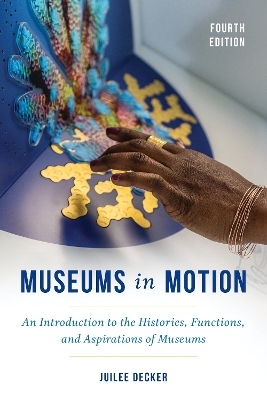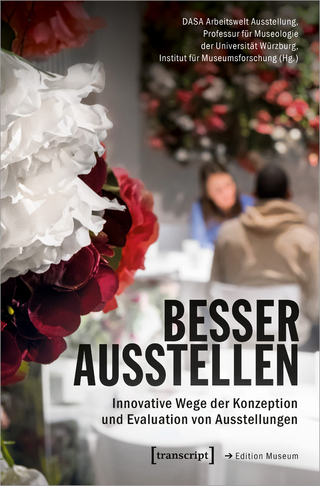
Museums in Motion
An Introduction to the Histories, Functions, and Aspirations of Museums
Seiten
2024
|
Fourth Edition
Rowman & Littlefield (Verlag)
978-1-5381-5573-8 (ISBN)
Rowman & Littlefield (Verlag)
978-1-5381-5573-8 (ISBN)
This book explores the histories and functions of museums while also looking at the aspirations of museums as they shift from their rather simple form of a treasury, storehouse, and tomb to something much more complex and people-centered.
This book explores the histories and functions of museums while also looking at the current standing of museums and their ongoing efforts toward relevance, resiliency, and future-proofing. Section I examines the beginnings of museums with chapters dedicated to art and design museums; natural history and anthropological museums; science museums; museums focused history and the past; and gardens, zoos, and children’s museums. Emphasis is on museums in the United States, with some historical framing beyond the U.S. Section II explores the primary functions of museums, including conservation, exhibition, interpretation, engagement, and service. Section III examines museums from within by exploring critical issues and contemporary movements facing museums and our society: transparency and openness, labor and equity, belonging and coalition-building, risk-taking and risk aversion, and sustainability and empathy. Advocating for change rather than “death to museums,” Museums in Motion demonstrates the very premise that museums have been in motion all along, as they have shifted from their rather simple form of a treasury, storehouse, and tomb to something much more complex by deeply considering where museums have come from, where they are today, and where they are going.
Entirely new to this edition, Section III (Museum Aspirations) features five new chapters, each centered around topics, rather than a museum type or museum function. Each topic is meant to be a micro-narrative and springboard for a conversation about museums today and their sustainability in the future. The chapters examine museums from the inside (museum workers and their voices, especially, as well as power held by people and institutions) and DEIA without using those individual words as chapter headings. On their own, or in conjunction with the chapters in the previous sections of this book, these chapters serve as vignettes that can help readers to understand where, how, and why we need to apply critical lenses to institutions and articulate how doing so helps us to understand this historical moment and, ultimately how we can realize resiliency and sustainability for museums and those who make their existence possible.
This book explores the histories and functions of museums while also looking at the current standing of museums and their ongoing efforts toward relevance, resiliency, and future-proofing. Section I examines the beginnings of museums with chapters dedicated to art and design museums; natural history and anthropological museums; science museums; museums focused history and the past; and gardens, zoos, and children’s museums. Emphasis is on museums in the United States, with some historical framing beyond the U.S. Section II explores the primary functions of museums, including conservation, exhibition, interpretation, engagement, and service. Section III examines museums from within by exploring critical issues and contemporary movements facing museums and our society: transparency and openness, labor and equity, belonging and coalition-building, risk-taking and risk aversion, and sustainability and empathy. Advocating for change rather than “death to museums,” Museums in Motion demonstrates the very premise that museums have been in motion all along, as they have shifted from their rather simple form of a treasury, storehouse, and tomb to something much more complex by deeply considering where museums have come from, where they are today, and where they are going.
Entirely new to this edition, Section III (Museum Aspirations) features five new chapters, each centered around topics, rather than a museum type or museum function. Each topic is meant to be a micro-narrative and springboard for a conversation about museums today and their sustainability in the future. The chapters examine museums from the inside (museum workers and their voices, especially, as well as power held by people and institutions) and DEIA without using those individual words as chapter headings. On their own, or in conjunction with the chapters in the previous sections of this book, these chapters serve as vignettes that can help readers to understand where, how, and why we need to apply critical lenses to institutions and articulate how doing so helps us to understand this historical moment and, ultimately how we can realize resiliency and sustainability for museums and those who make their existence possible.
Juilee Decker, Ph.D., is professor of history at Rochester Institute of Technology where she directs the Museum Studies/Public History program and co-directs the Cultural Heritage Imaging Lab. She earned her Ph.D. from the joint program in art history and museum studies at Case Western Reserve University/Cleveland Museum of Art. She serves as editor of the peer-reviewed journal Collections (SAGE).
| Erscheinungsdatum | 29.07.2024 |
|---|---|
| Reihe/Serie | American Association for State and Local History |
| Verlagsort | Lanham, MD |
| Sprache | englisch |
| Maße | 177 x 253 mm |
| Gewicht | 748 g |
| Themenwelt | Kunst / Musik / Theater |
| Geisteswissenschaften ► Geschichte ► Hilfswissenschaften | |
| Wirtschaft ► Betriebswirtschaft / Management ► Unternehmensführung / Management | |
| ISBN-10 | 1-5381-5573-7 / 1538155737 |
| ISBN-13 | 978-1-5381-5573-8 / 9781538155738 |
| Zustand | Neuware |
| Haben Sie eine Frage zum Produkt? |
Mehr entdecken
aus dem Bereich
aus dem Bereich
Anforderungen an das digitalisierte Kulturerbe
Buch | Softcover (2023)
transcript (Verlag)
29,00 €
innovative Wege der Konzeption und Evaluation von Ausstellungen
Buch | Softcover (2024)
transcript (Verlag)
37,00 €


